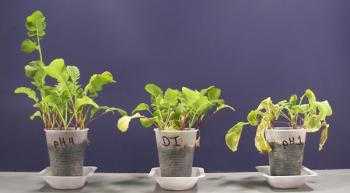The reaction of the environment plays an important role in the absorption of ions from the soil or from the nutrient solution. In a highly acidic environment (at pH <4,0), hydrogen ions are toxic to the plant. They displace all other cations from the state of adsorption, and instead of being absorbed, one can observe their release from the root. In a strongly acidic environment, the appearance of the roots and their structure change. In an alkaline environment (at pH> 8), the absorption of anions by plants is disturbed.
In a less acidic environment (at pH = 4,5-5,0), hydrogen ions do not cause a direct toxic effect. However, in soils with this pH, many crops grow poorly. This is due to the fact that in acidic soils, the flow of calcium into plants is delayed, and the activity of beneficial microflora is also disrupted. In addition, acidic soils accumulate a large amount of ions of iron, manganese and especially aluminum, harmful to plant growth, which are in a bound state in non-acidic soils. In acidic soils, the absorption of phosphates and molybdenum by plants decreases. That is why acidic soils need to be limed to obtain high yields.

Influence of the pH of the nutrient solution on the growth of tomato seedlings
(from Ernon and Johnson, quoted in Sabinin, 1955)
solution pH
Raw weight of one plant, g
4,0
35,3
5,0
103,7
6,0
111,8
7,0
100,3
8,0
64,5
9,0
7,0
The data given in the table indicate that the most favorable conditions for growth in artificial cultures are created at pH = 5,0-6,0.
In soil, under the influence of plant growth, the pH changes slightly, since the soil has a high buffering capacity, that is, the ability to maintain pH at a certain level. Nutrient solutions do not have this buffering capacity, and therefore their pH is easily shifted to the acidic or alkaline side under the influence of plant growth. The nutrient solution can be artificially buffered. For this, it is necessary to additionally introduce into the solution substances capable of forming buffer solutions.
Why does acidity change
The shift in the acidity of the solution occurs as a result of uneven absorption of cations and anions from the nutrient solution by the root. For example, if ammonium salts are included in the nutrient solution formulation, then the solution is usually acidified, since plants absorb ammonium nitrogen at a high rate compared to the accompanying anion; on the contrary, in the presence of nitrate, plants consume nitrate nitrogen at a higher rate, as a result of which the solution becomes alkalized, since it is enriched with alkaline salt residues. Experience has shown that large amounts of ammonium salts cannot be added to the nutrient solution, for the reason that they damage plants due to the strong acidification of the solution. In the most common solutions, including the Hydroponics Kit, nitrate rather than ammonium nitrogen predominates; in practice, the solution becomes alkalized, and it must be constantly acidified.
conclusions
Thus, when growing plants without soil, it is possible to accurately regulate root nutrition, the ability to provide plants with all the necessary nutrients well. Therefore, in artificial culture, you can get high yields of plants. However, there are also a number of difficulties. First, the danger of flooding the root system, which can lead to the death of plants. This danger is eliminated with the help of various technical equipment. Secondly, there are shifts in the acidity of the solution (usually alkalinization), which can adversely affect plant growth. Therefore, it is necessary to frequently check the pH of the nutrient solution and bring it to the optimum value.